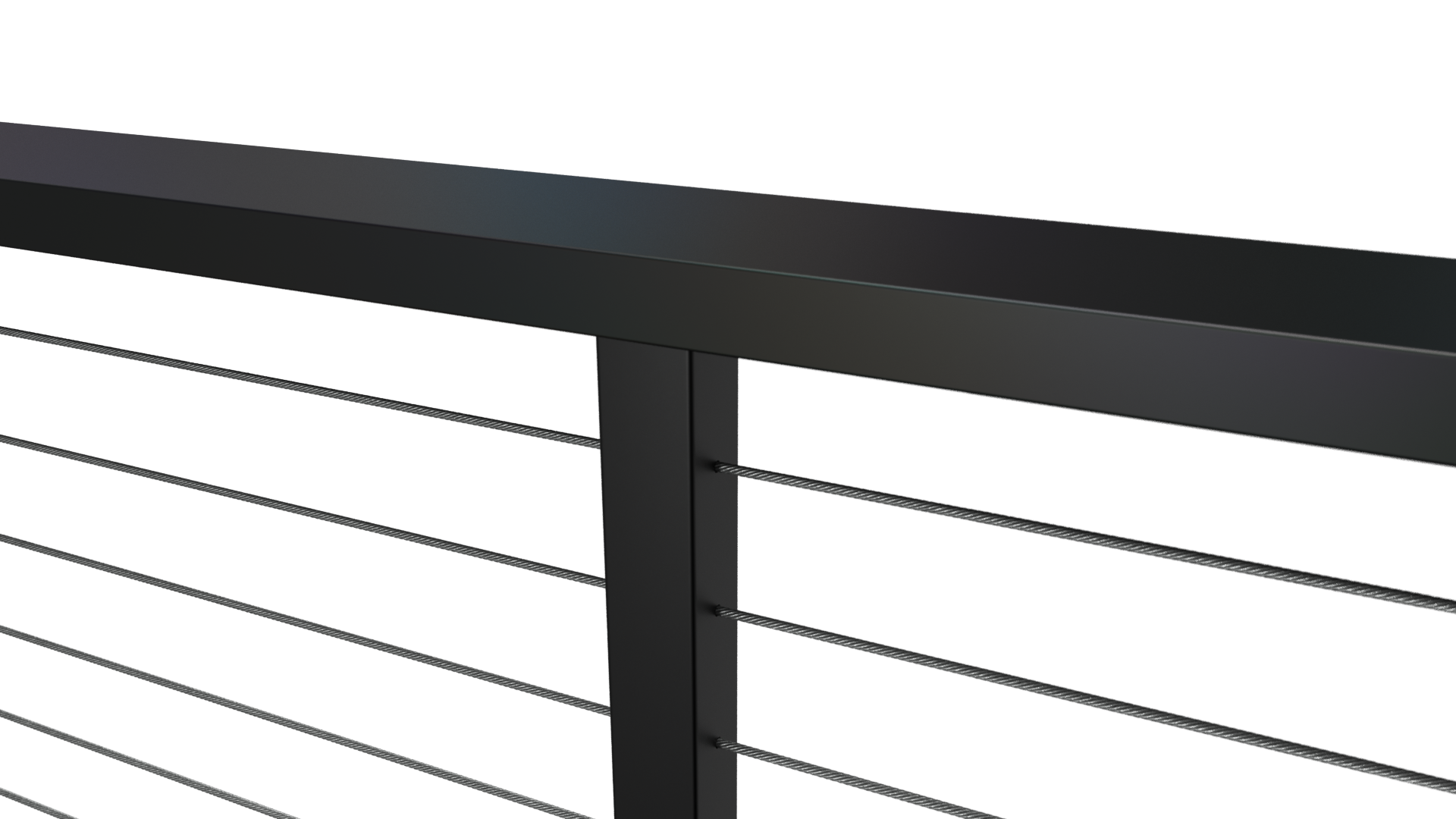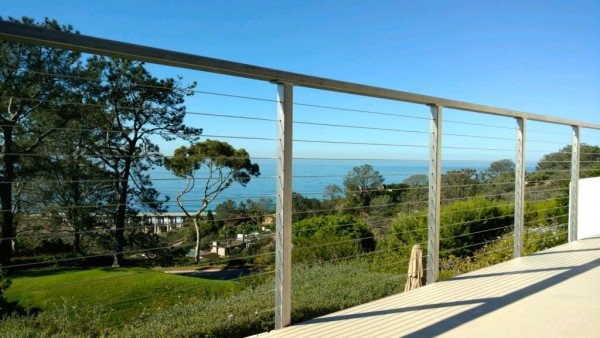




There are several types of interior and exterior railings and railing post types available in today’s marketplace. Reviewing the different mounting types, recommended spacing, materials, colors and applications can be daunting at times. In this post we aim to clarify some of these details and offer some common terminology regarding the most popular railing post types. Most of the reference material is geared towards stainless steel cable and glass railing systems as those make up the majority of our sales and installations. Structural Railing Posts Depending on the type of railing system there may be a single type or many type of posts used to support the infill and top rail. Structural posts refer to those designed to sustain lateral and possibly tension loads within a railing system. An “end post” or a “corner post” within a cable railing system refer to structural railing posts. In comparison, a “spreader post” would not be considered a structural railing post as its purpose is not primarily structural and mainly aesthetic. A common spacing recommendation for structural railing posts is between 4 and 6 feet on center spacing. Cable railings require tighter spacing for structural posts than picket railings due to tension loads and spread. The most common recommendation for cable railing systems is 4′ on center, while glass panels might be 5′ on center, and various picket or rod infill systems can push to the 6′ on center spacing. These are generic guidelines as systems and municipalities vary. Installers should follow recommendations and current codes. Glass Boot and/or Base Shoe Support Systems Although not technically a railing post, base shoes are becoming more and more commonly used for glass railing systems. A “base shoe” or “boot” is secured to the deck surface and acts as a structural clamp and support for heavy duty tempered glass panels. Structurally, a boot system is one of the only secure ways to support glass panels without the use of railing posts. Base shoes are engineered for structural use and support, requiring grout or a special locking system to secure the panels and support system. Recent updates have called out the use of laminated glass more and more often for “no top rail” glass systems. A base shoe mount is a proven way to safely achieve this type of install. Railing posts of different types and sizes can also be used in lieu of base shoe for installing glass panels. Typically glass clips (small clamping mechanism) are attached to structural railing posts in order to secure glass panels for this type of installation. Additionally, there are full framed glass systems which utilize channel and/or full framed glass railing with top and bottom railings and structural posts every 4-5′. Intermediate Posts, Spreader Posts, and Slim Line Railing Posts Intermediate posts like the one photographed above are also called “spreaders” or “line” posts. This type of railing post is often utilized to increase a viewing window without the larger profile of a structural post. As photographed the structural posts are 2″ square while the spreader post is a mere 3/8″ wide profile. The intermediate (spreader) post provides some rigidity and prevents the stainless steel cables from spreading, without the need for the heavy wall or width of a 2″-4″ post. When dealing with cable railings, glass, and other low visibility systems; spread is key to opening the view. When utilizing spreader posts between structural posts, installers can achieve clear windows of 6-7 feet without fear of code compliance or stability issues. Additional Notes on Railing Posts and Terminology Consumers should note that railings and fencing are very different when it comes to spans and spacing. There are many photographs found online that illustrate posts, pegs, clips, and all different kinds of spacing that may or may not satisfy code requirements for a safety railing. Just because photos exist, does not mean it will satisfy an inspection. Windbreaks and fencing may not require the same safety measures as a second story deck. Railings with and without top railing members will often have different rules and code requirements. Our company (San Diego Cable Railings) has been furnishing railing kits to homeowners and builders nationwide since 2009. We furnish a variety of railing posts for cable, glass, rod, and horizontal panel systems. Our welded connections and high grade stainless posts have been engineered to satisfy loading requirements, and even our spreader posts provide unmatched strength and elegance for your home. If you have questions about any of our railing post types or would like to obtain pricing for a railing system, give us a call or visit the quote request form today.

Disappearing Guardrails Using Stainless Steel Cable Railings- Cable Railing customers often request recommendations for the most “invisible” or “transparent” color selections when choosing a railing package. Opinions from different online sources will vary when it comes to this topic, however after constructing hundreds of decks and railings with all different types of backdrops we believe there are some clear choices. The most transparent railings will offer the fewest solid members and feature minimal profiles. Post and railing finishes should be muted, avoiding heavy solid colors and reflective surfaces. Disappearing guardrails will blend into surrounding landscapes of all different types and colors, and pick up or reflect hues from trees and shrubs. The same parameters must be met when dealing with coastal settings where transparency is usually the #1 factor for choosing a railing system. For our coastal and landscape railings and fencing, the clear choice is bare stainless steel. Much like stainless steel cables, bare stainless steel railing posts and rails pick up colors from the existing landscape and reflect their surroundings. When combined with stainless steel or hardwood top railings our bare stainless cable railing posts are the most utilized finish option for transparency. SDCR stainless posts are furnished with a non reflective clean matte finish which offers the beauty and durability of stainless steel. Bare stainless features neutral grey tones with a slight sparkle; no concerns about fingerprints or other drawbacks associated with polished finishes. For maximum daylight openings with the least amount of visible obstruction, “ultra slim” stainless steel spreader posts can be utilized in between structural posts. The use of spreader posts will allow the installer to space structural posts up to 7′ for a wide open view and feel. We also offer powder coating to all of our stainless steel post options, usually recommending a neutral tone like medium grey when transparency is a must. Despite some popular articles and design theories about black railing posts for transparency; we have found black to be more visible during daylight hours in addition to drawing more UV rays. Stainless Steel Cable Railings are transparent even at close range with high resolution cameras, with no glass to clean or maintenance issues offered by other railing types. If you have questions about our bare stainless steel product line, give us a call at 844-277-7327 and speak with one of our cable railing pros 8am-5pm mon-fri.
SDCR is currently offering a late summer special on discount railing posts. For a limited time only and while supplies last we are offering an awesome discount on our most popular railing post choices for cable deck railings. Fascia mounted stainless steel railing posts available for 36″ or 42″ railing types. These railing posts attach directly to the fascia of your deck and include stainless steel mounting bolts and fasteners. All necessary hardware is included! Our stainless cable railing posts are made locally, from domestic tube steel and utilize welded connections. Cable railing customers will not find a better value industry wide for cable railing posts. Additionally, these posts work great for cable rail fencing projects. Our preferred installers have utilized these posts to cast in masonry walls, or concrete footings, as well as the standard fascia mount attachments for a very versatile and durable cable fencing option. Discount railing posts are compatible with all of our most popular DIY cable assemblies and can be utilized with 1/8″ or 3/16″ stainless steel cable. They are a perfect combination with wooden or hardwood top railings. Our DIY and contractor clientele across the country can attest to the quality of our products and the customer service offered by our sales and production team. We specialize in assisting our customers with code compliant cable railing solutions and cost effective designs, without sacrificing quality or aesthetics. Deck season is in full swing, take advantage of our cable railing special offers while supplies last! FREE SHIPPING on all online cable railing orders over $2500!! Check out our online store or click on the link below to view options and pricing on our special offer railing posts. [ec_product productid=”278″ style=”1″]